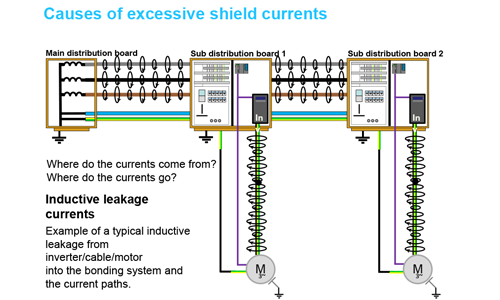Vagabonding currents
(in industrial plants)


„Vagabonds" are prowlers according to the dictionary. The term can be traced back the Latin adjective "vagus" which has the sense of: fortuitous, erratic, rambling. If you would follow this translation, then you would have to actually call all currents vagabonding or meandering currents. For it is in the nature of things that currents flow and seemingly follow their own rules. Nevertheless, electricians understand vagabonding currents as a special phenomenon – these are interference currents that flow over parts of the equipotential bonding or other conductors that are not intended for that.
In a TN-C network, vagabonding currents search for earth and/or other conductive materials instead of the neutral conductor to flow back to the current source. All that they need for that are connections between the neutral and earth conductors which are available in the industrial environment – sometimes intentionally but usually unintentionally. As lower or higher frequency currents, the "vagabonds" preferably choose the shields of industrial data lines. They often provide the shortest return current path to the current source and also the path of least impedance. That makes line shielding more attractive than the equipotential bonding. The problem with that: Shield currents cause a greater wear of the network devices and infrastructure in the long run. And they often cause interferences in the data traffic.
Often vagabonding currents are associated with high voltage, for example with electric railroads. That they also occur on low-voltage systems and communication networks (like PROFINET networks) is not known by many industrial plant / system operators. If there are malfunctions, they often look for the fault source in devices and components without getting to the bottom of the actual cause. Especially tricky: Vagabonding currents can also affect peripheral devices which makes troubleshooting all the more difficult.
 Causes for shield currents / vagabonding currents
Causes for shield currents / vagabonding currents
The quality of a low-voltage system stands and falls with the equipotential bonding. It ought to be ensured that the impedance of the equipotential bonding system is less than the impedance of the shield. Indu-Sol recommends the following guidelines:
An intermeshed equipotential bonding can reduce electromagnetic interference significantly. The tighter the meshing, the greater its effect. Using the mesh resistance measuring clamp MWMZ II, the corresponding values can be determined precisely. If the weak spots of an equipotential bonding system need to be found, then the LSMZ I leakage current clamp is the suitable measuring tool. It finds out at which point in a network parasitic currents occur. It is equipped with a broad frequency band for this task which ranges from 50 Hz in the low frequency to 3 kHz in the higher frequency range.
If the causes of a communication malfunction in the network cannot be clearly identified, long-term EMC measurement may provide important indicators: The intelligent current clamp ISMZ I monitors conductor-bound interference currents for a duration of up to fourteen days. Its installed memory records all measured data. The measuring clamp is furthermore capable of evaluating data independently. Using the supplied software, you can delve into the evaluations and make initial assessments on the electromagnetic compatibility (EMC) of the examined network.
If you desire support during the fault analysis and optimisation, then Indu-Sol is your competent partner. Our technicians will gladly take over the necessary measurements for you. Furthermore, we can advise you on the sustainable improvement of the equipotential bonding and offer you the EMV-INspektor® V2 as a device for permanent monitoring and diagnosis of electromagnetic interferences. It functions as a passive monitor for up to four different current-carrying channels. With it you can keep an eye simultaneously on the behaviour of the shield currents, the currents in the equipotential bonding system, the PE currents in the motor cable and the course of the 24 V(DC) supply.
We will be happy to help you. Just send me a mail or give me a call.
Stay informed! Receive the latest offers and news about industrial networks and their optimization - conveniently via e-mail.
EMC & Equipotential Bonding in Automation - Read here the practical experience report on the current state-of-the-art by Prof. Dr.-Ing. Niemann, Karl-Heinz, published in atp magazin 4/2019*.
*licensed at Creative Commons-License - CC BY - 4.0 International [unchanged]